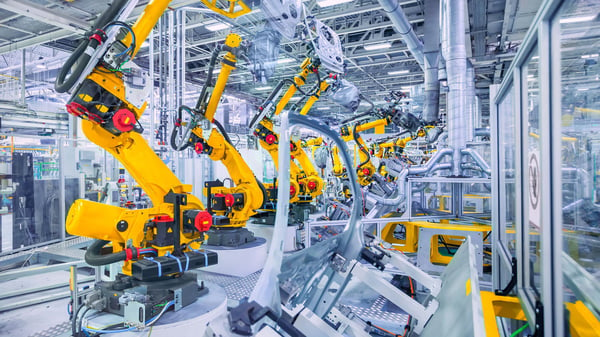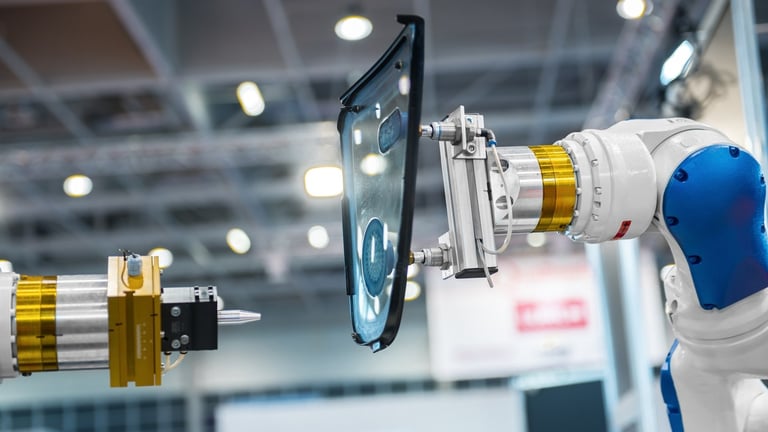It's 2020 and industrial automation is entering the new decade with some exciting prospects in store terms of innovation and development. Here is a figure to demonstrate: according to a report by the International Federation of Robotics (IFR), sales of industrial robots will grow at an average annual rate of 12% until 2022, far exceeding the 580,000 units recorded last year.
What can we expect from this unstoppable phenomenon which will shake the foundations of industrial engineering as we have known it so far? Read on for BETWEEN's overview of industrial automation trends in 2020 to find out.
What is industrial automation?
Industrial automation is the use of machines and technological systems in production processes, in such a way that they take the place of humans in more mechanical and repetitive tasks. Industrial automation saves time, alleviates operator workload and reduces the number of issues attributable to human error.
What is the purpose of industrial automation?
Industrial automation leads to improvements in four very specific areas:
- It helps achieve a more homogeneous production and with fewer errors.
- It helps to handle larger volumes in a shorter space of time.
- Cost reduction. It helps to cut expenses relating to materials and labour, among other areas.
- Worker satisfaction. It leads to a reduction of stress and accidents among the workforce, while taking over from it in operations which are cumbersome, arduous or dangerous. In this way, staff can focus on activities with an intellectual component and which require more expertise.
This will lead to a growth in productivity, greater profitability for the business and an increase in ROI (return on investment).
What is industrial automation with PLC?
Industrial automation with PLC (programmable logic controllers) is the easiest and most efficient way to organise the running of the machinery within a factory. PLCs are electronic devices that can be programmed to automatically issue certain orders in specific situations.
PLCs monitor the progress of industrial processes in real time. Advantages of their use include their flexibility, since they can be quickly updated to handle any change by means of programming; and the existence of communication protocols for instant coordination with other computers and PLCs.
Where is industrial automation used?
The potential applications of industrial automation extend to companies of all sizes and from all sectors, although it is more prominent in sectors such as automobiles, food and metallurgy, as well as in the chemical and pharmaceutical industry.
Examples of industrial automation
Some of the most widely used examples of industrial automation are to be found in:
- Assembly lines. Machinery that takes care of the continuous assembly of parts as well as their mounting, screwing, welding, etc.
- Adding components. Systems that create chemical or food mixtures by means of the progressive addition of different ingredients in the proportions assigned.
- Technology that is capable of handling different types of packaging materials, even the most fragile (e.g. glass), and produce flawless packaging, with labelling included.

Types of industrial automation
There are three types of industrial automation:
- Fixed industrial automation. These are relatively simple and economical machining systems, designed to carry out a specific task. They have the disadvantage that, in the event that this activity becomes unnecessary, they cannot be reused for a new task. However, they are the best option when you want to produce very high volumes of a single item at the fastest possible rate.
- Programmable industrial automation. Ideal for the production of different types of objects in batches. They are not as fast as fixed systems, but their configuration can be adapted according to needs.
- Flexible industrial automation. They combine the benefits of fixed and programmable technology: the production rate is comparable to the systems of the former, while also allowing you to introduce small modifications during the process.
Automation of industrial processes: 2020 trends
The industrial automation trends that 2020 will bring are in response to the complexity of the challenges posed by a globalised and hyperconnected world. Here at BETWEEN, we have selected the four that, in our opinion, will have the greatest influence on the evolution of industry 4.0 over the next decade:
1. Blockchain for industrial automation
The decentralised information management provided by blockchain technology will accelerate industrial automation in two areas:
Traceability and supply chain monitoring
Monitoring a product's traceability has always been an obsession in the food industry. With blockchain, this dream will finally come true. Thanks to the distributed storage of the data, the communication of the information between the different nodes is simplified while at the same time making it more difficult to falsify entries. The result is a more reliable real-time monitoring of the supply chain.
IoT inter-device coordination through smart contracts
The alliance between 5G, the Internet of Things (IoT) and edge computing will help industrial automation to reach new levels of sophistication. The base will be provided by one of the appplications of blockchain, smart contracts, scheduled to run without external involvement once certain prerequisites are met.
In this way, the machines will gain autonomy and will be able to negotiate among themselves in order to find solutions in the production process. On a practical level, it will be possible to authorise payments, fill out purchase orders, notify in case of malfunction and activate production when certain conditions are met and without the need for human involvement.
2. Robotics
As we saw at the beginning of this article, 2020 will mark the beginning of the golden age of robotics in industrial automation. Two kinds of robots will be particularly prominent in this area:
Collaborative robots
Collaborative robots are systems designed to work in collaboration with a person. In general, they are relatively simple devices which can be programmed even by operators without specialist knowledge. They are also very safe to handle, since they have sensors that anticipate risks and prevent collisions.

According to Statista, by 2022 cobots will represent 8.5% of the total number of industrial robots.
Exoskeletons
Exoskeletons are a kind of robotic costume that fit on to the body of the worker to help them perform heavy duty tasks with greater safety, or to facilitate the execution of certain actions which they would not be able to handle by themselves. Examples are:
- Passive exoskeletons, which promote ergonomics in the workplace, proportionally distributing the weight of the load between the strongest muscles and assisting in maintaining difficult postures.
- Human augmentation, that is, technology that expands human capabilities. This includes, for example, artificially lengthening limbs, increasing visual acuity, improving hearing and adding extra fingers in order to be able to grasp more objects simultaneously.
3. Time Sensitive Networking (TSN)
Time Sensitive Networking (TSN) is a set of Ethernet standards, developed by the IEEE (Institute of Electrical and Electronics Engineers), which enables open and real-time communication between different devices with a very low latency.
This machine-to-machine communication made possible by TSN is key to the advancement of industry 4.0, since it does away with the issue of incompatibility between protocols, it eliminates barriers to IoT connection and it guarantees security in the exchange of information. It is most effectively used with SoC FPGA programmable devices.
4. Machine learning
We will see industrial automation at its glorious best thanks to machine learning. As the IoT is implemented in industry, the perfect scenario for big data to get involved will be created. In other words, the volume of data collected will allow machines to identify patterns, draw their own conclusions and act accordingly.
In this way, they will be able to anticipate spikes in demand, stock depletion, malfunctions and other issues, and to take measures to address these under optimal conditions. One could say that the technology will end up knowing more about the business than the engineering professionals in charge of the company's operations ... and even than the business owners themselves.
The European Commission expects that, by 2020, there will be 10.43 million people working in jobs related to big data in Europe. That's almost four million more than in 2016. In fact, according to the EC, there will be no less than 769,000 hard-to-cover jobs within the so-called Data Economy due to the shortage of specialists with the necessary training and skills.
Given these predictions, the Spanish labour market offers excellent growth opportunities for engineers who are up to date with trends in industrial automation. Check out the job offers from BETWEEN and - who knows? - the future could be bright...


